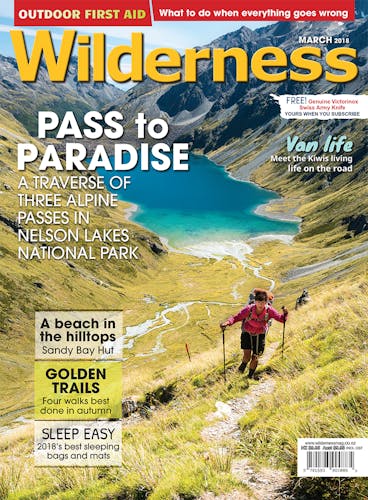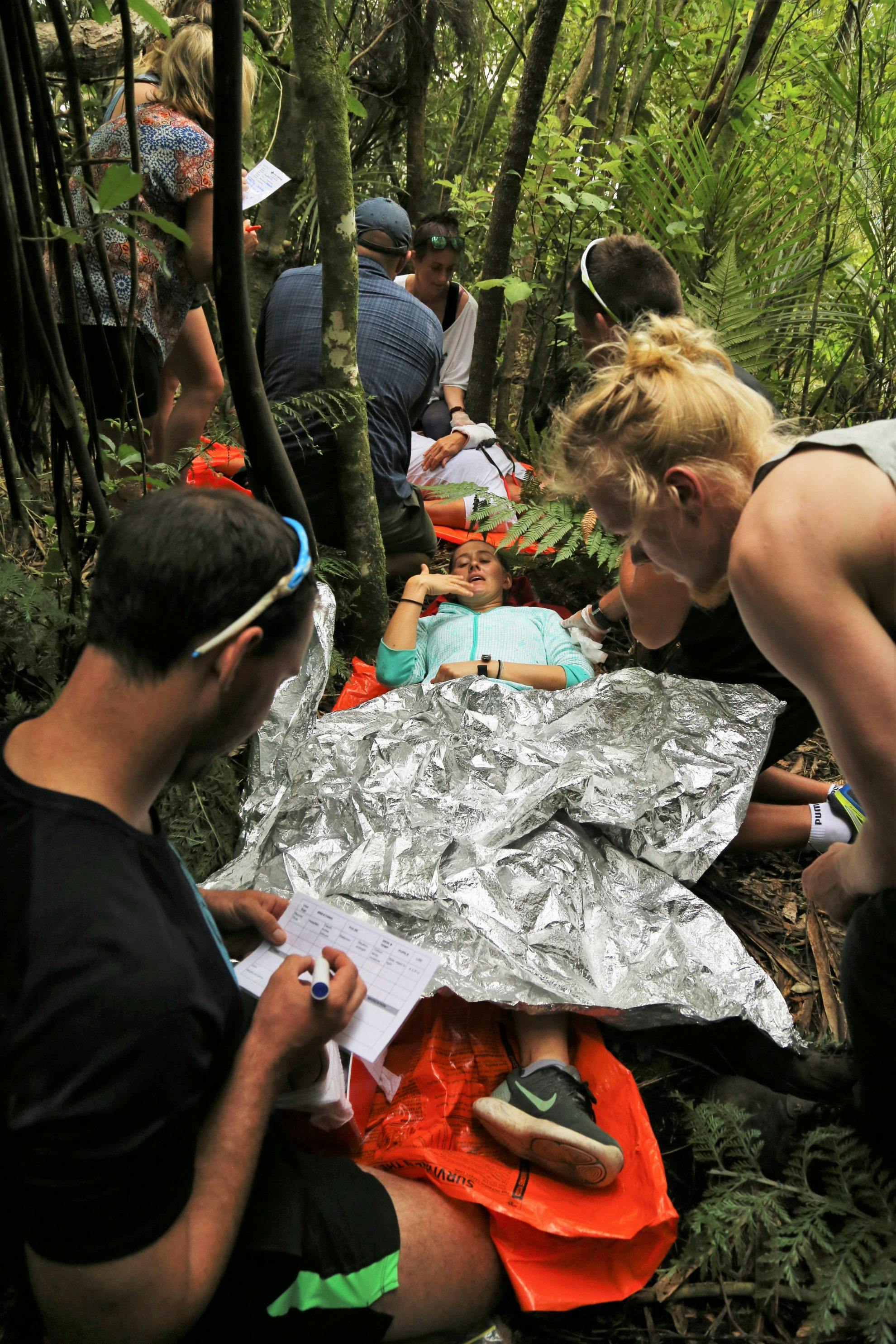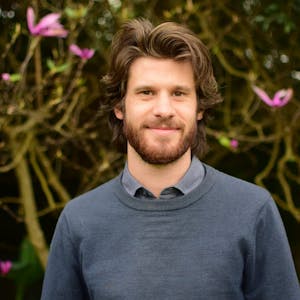George Driver attends an outdoor first aid course to learn what to do when everything goes wrong
We could hear the screams through the bush before we arrived at the scene. Through the manuka scrub, we could see bodies on the ground. Our instinct was to rush in and help, but we paused and took a deep breath before continuing. The first patient was unconscious and heavily bleeding – her hand was severed. I stopped as the rest of the group rushed on towards the screaming person. My head was whirring with questions. What am I meant to do? Check responsiveness. I call to her, no response, I tap firmly on the collarbone, just as we had learned, and suddenly she sat bolt upright, screaming. So she’s conscious and breathing – what next? I do my best to bandage the stump of her arm and try to get her warm by sliding a mat underneath her and wrapping her in an emergency blanket. Still, I make a meal of it. I forget to elevate her limb; I begin asking if she has a medical condition or allergies and miss the massive fracture on her leg, hidden beneath her trousers; I take her pulse with my thumb. I didn’t even ask her name.
Fortunately, I’m on an outdoor first aid course and this is just an exercise. But it’s an excellent illustration of how the techniques we learned in the classroom can become muddled when faced with a real-life scenario.
Seventeen people had enrolled in the course run by First Training, based at the Arataki Visitor Centre in Auckland. The group was a mix of people who work in the outdoors; guides, school teachers and even a couple of tourists. Over the next two days, Danny Tenheuvel, a lifeguard at Muriwai and former paramedic, took us through a number of nightmare scenarios, each time increasing our confidence administering first aid.
According to the Mountain Safety Council’s 2016 report There and Back, on average of six people die each year while tramping and 3146 are injured. If you are injured, it could be hours, or even days, until help arrives. Tenheuvel explains that while a standard first aid course teaches the skills for responding to an incident in the minutes before an ambulance arrives, an outdoor first aid course goes further, teaching the skills to look after someone in an isolated environment, exposed to the elements for hours.
To get us in the mood, Tenheuvel shows us a video of a group of mountain bikers skirting a hair-raisingly narrow track above a steep drop. We watch as one of the bikers slows, his centre of gravity shifts, and he plunges over the precipice, bouncing off rocks before coming to a rest in scrub. Faced with this scenario, what would you do first?
Tenheuvel tells us the gold standard of first response is the acronym DRS ABC, which sets out how to assess a person who requires first aid: stop and check for Dangers, check the patient’s Responsiveness, Send for help, check and open their Airways, check their Breathing and Circulation by looking for severe bleeding and other clues. If the person isn’t breathing, start CPR.
Having just seen someone tumble off a cliff, the first instinct may be to rush over the drop after them. You have to ignore that instinct, Tenheuvel says.
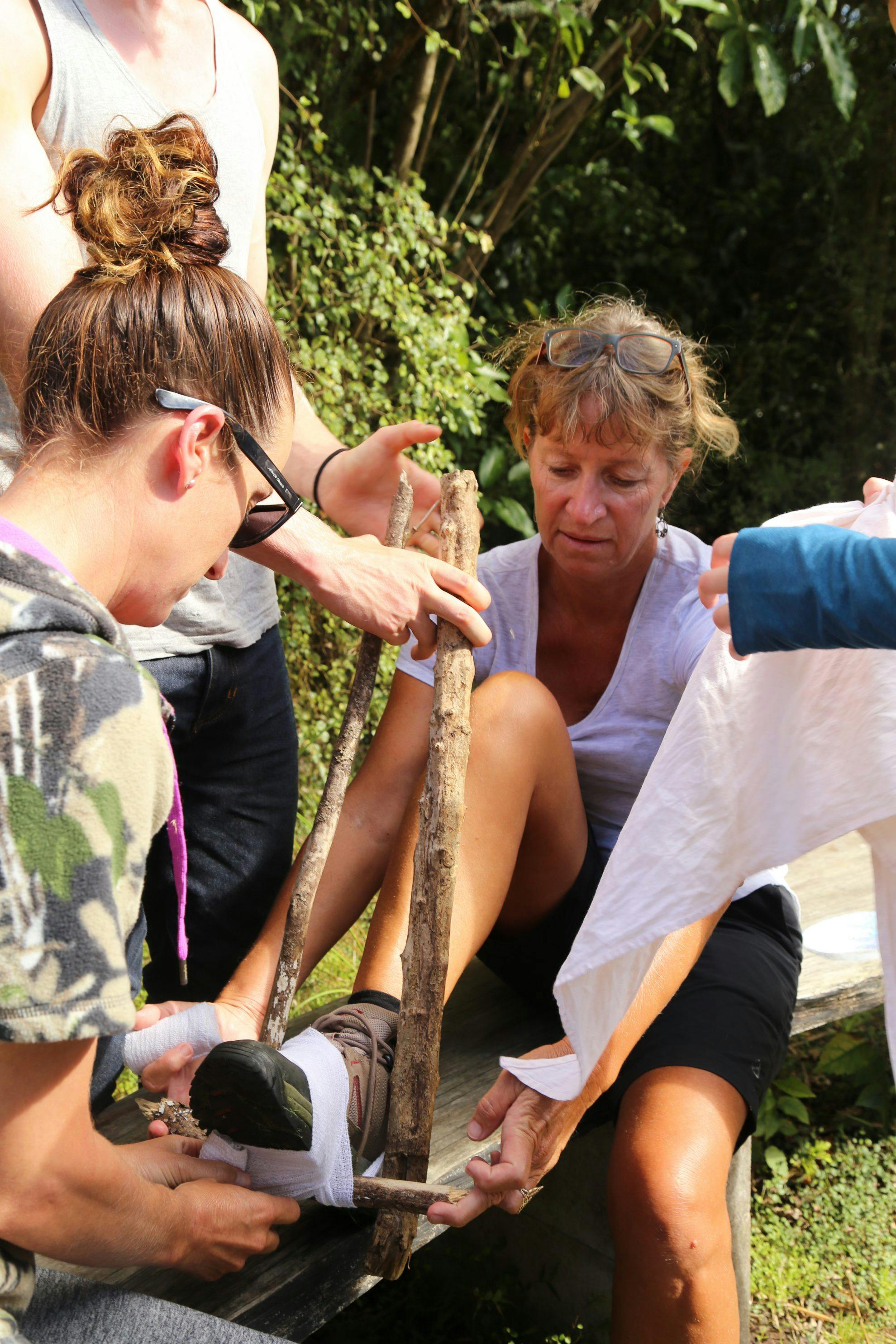
You can improvise
a splint in the bush
using sticks to immobilise the injured area. Photo: George Driver
“Don’t just rush in there. Your personal safety comes first, the injured person actually comes last. So stop and look: has the person been injured by falling rocks, is the thing that has injured them going to injure me?”
Once you have established whether it is safe to approach the person, you need to check their responsiveness. If they don’t respond when you talk to them, you need to thoroughly check if they are conscious by tapping them firmly on the collarbone or even twisting their ear.
“Some paramedics even dig their keys into the person’s fingernail bed to check,” Tenheuvel says.
If the person is unresponsive, we are taught how to open their airways by tilting back their head and lifting their chin and to check their breathing for 10 seconds, by looking to see the rise and fall of their stomach and listening and feeling for their breath.
“In reality, this check usually takes a few seconds,” Tenheuvel says. “If they are crying out, you already know they are responsive and breathing.”
We were then shown the CPR technique (30 compressions at a rate of two a second, compressing to a depth of a third of the chest, followed by two breaths), which we practise on dummies. Tenheuvel says CPR is only successful about 10 per cent of the time – but it can keep people in a state where they can be saved by a defibrillator, which has much higher success.
The next part of the course covers how to assess and monitor a person who requires first aid, using the SAMPLE checklist: check the person’s Signs and symptoms and ask about any Allergies, Medical conditions and medications, their Past medical history, Last oral intake and the Events leading up to the injury or illness.
If you find a person who requires first aid, there may be a range of causes, Tenheuvel says. The SAMPLE method provides a basic strategy to determine the problem, whether someone is going into anaphylactic shock from a bee sting, suffering a heart attack, or has concussion, a broken bone or severe blood loss, through to medical conditions like diabetes.
This involves assessing a person’s breathing rate, skin colour, level of consciousness, whether they feel dizzy and their heart rate. It also includes doing a body scan for any hidden injuries.
We then learn how to treat common injuries, such as severe bleeding (apply direct pressure to the wound by tightly wrapping with a bandage and elevating the injured area) and broken bones, including how to make an improvised splint using a stick, firmly binding the stick to the limb to immobilise the joint both above and below the break. We are shown how a pack liner can be used as a stretcher, by either inserting sticks found or cut from the bush, or even simply rolling up the sides of the bag to give it greater strength. The bag is surprisingly strong and we practise lifting patients in the foyer of the visitor centre. It’s relatively easy with six people lifting a person over flat and open terrain.
Having learnt the first aid basics, Tenheuvel has devised a range of scenarios brought to life by some respectable amateur acting and gory special effects, to put us to the test. The scenarios require every element of the SAMPLE survey – victims often had hidden injuries, medications and medical conditions which we had to uncover using the first aid techniques.
In the first scenario, we have to stretcher the worst patients to an area so they can be evacuated by a helicopter. We soon realise carrying someone in the bush is an entirely different proposition. Maneuvering them up a slope, around trees and through scrub was slow-going and very difficult. In a panic, we also shift someone who didn’t need to be moved, even forgetting to splint their broken leg before helping them to hobble out of the bush.
“You need to have a really good reason to shift someone,” Tenheuvel says. “In most cases, it’s going to be better to attend to someone where they are, and only shift them if it’s absolutely necessary.”
Other scenarios involved an injured hunting party that we had to move to shelter before an incoming storm hit. One member had been shot, one had a severed limb, one was impaled and most of them had aggravating medical conditions that we had to discover by going through the SAMPLE survey. Although the examples were extreme, it was a thorough test of how to keep calm under pressure and remember the basics of first aid. It’s by learning from our mistakes in a safe environment, supervised by an expert, that we can do our best in a real-life situation. After nearly an entire day of running through scenarios, we all started to feel a lot more confident assessing and treating someone in the outdoors.
“If any of us had to deal with that again, we’ve already had some exposure to it, which is really important,” Jeanene Piper says. Piper is a member of the Women’s Outdoor Pursuits club in Auckland and joined the course to gain skills for leading club tramping trips.
“The biggest thing for me was to stop and don’t panic – take a minute to assess the situation and the dangers,” she says. “I think it’s good for any tramper to do a first aid course. You never know what situation you may come across or what may happen in your own party when you’re on a tramp.”
Piper says she has printed a sheet with the DRS ABC and SAMPLE survey to keep in her first aid kit to remind her in an emergency.
The scenarios we went through were fictional, but there is no shortage of real-life examples where first aid has proved its worth in the outdoors. Victoria University of Wellington Tramping Club member Dominic Oberhumer was on an easy tramping trip to the Mangatainoka Hot Springs in Kaweka Forest Park. On the walk out, one of the party jumped into the Mohaka River to cool off.
“He jumped in without checking if there were any submerged rocks,” Oberhumer recalls. “At first he stood up and yelled to us ‘there are rocks, don’t jump in’, and he walked out of the river in a little bit of pain. Then he looked down at his legs and said ‘oh, this is a lot worse than I thought’.”
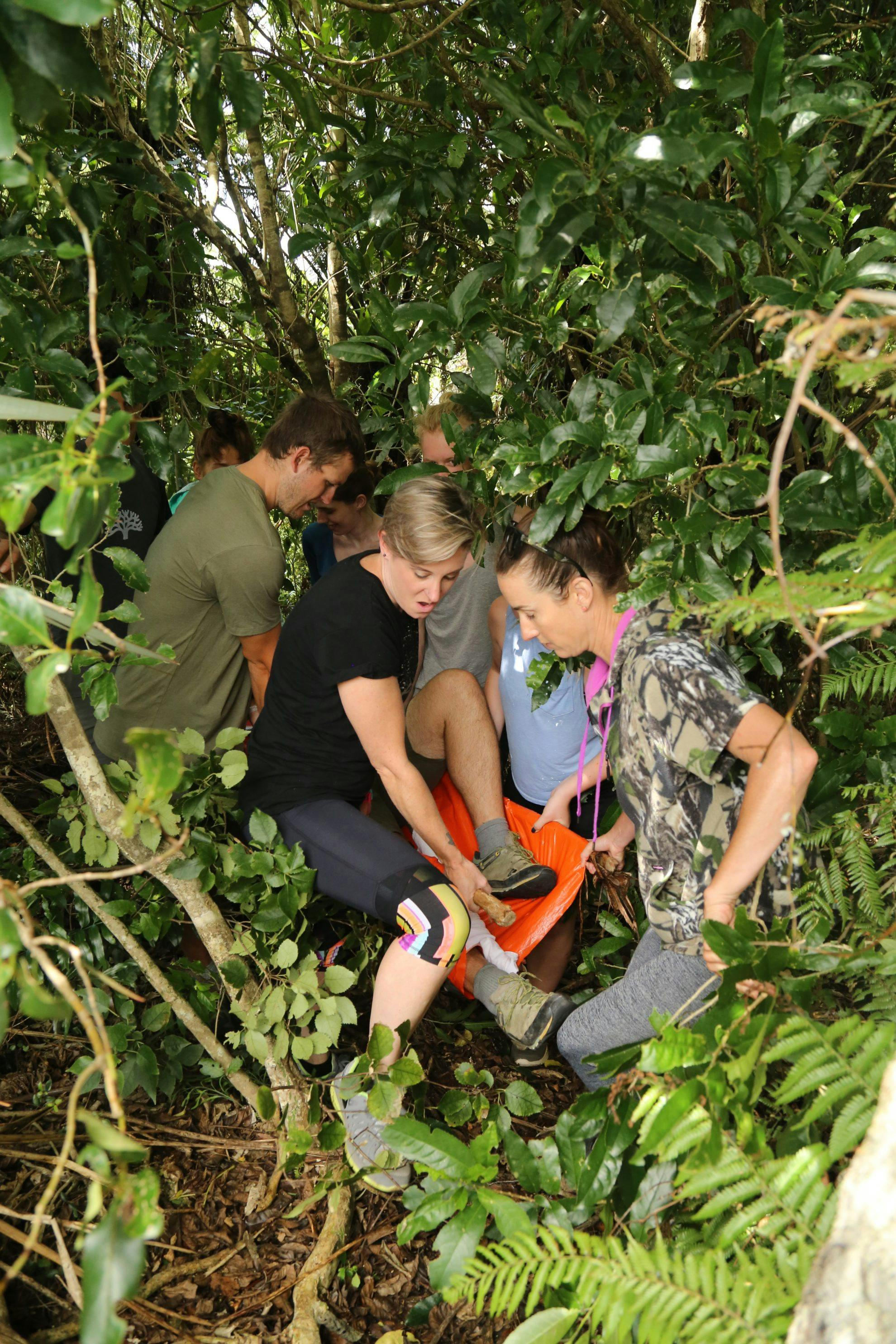
People on the first aid course attempt to evacuate a patient out of the bush using an improvised stretcher. Photo: George Driver
The man had deep cuts in his legs and was bleeding heavily. Oberhumer, the only person in the group with first aid training, sprang into action. He sent one of the group to activate a PLB in a nearby clearing before getting the victim to lie down and elevate his legs on a pack.
“I had a decent first aid kit and bandaged the wounds,” Oberhumer says. They were clean cuts and I made sure the bandages were tight and the blood didn’t seem to be coming through.”
Oberhumer then put him into a sleeping bag to keep him warm, but the man soon drifted into shock.
“He started shaking uncontrollably and he wasn’t making any sense – he was babbling and not finishing his sentences.”
He came around about 10 minutes later and the helicopter arrived within an hour. He was flown to Hawke’s Bay Hospital, where he got stitches and was released later that day.
Oberhumer says his first aid training meant acting in an emergency situation became second nature.
“It just kind of clicks. You think ‘something’s gone wrong, and I know how to fix it’. You just get on with it.”
He said while you can become flustered on scenarios at a first aid course, in reality there’s a lot of time to think things through.
“In a course, it’s really fast-paced and hectic, but when something has gone wrong you’ve probably got a lot of time. It could be several hours before help arrives and you can think through your decisions and re-evaluate and make any changes if necessary.”
Wanaka SAR veteran Gary Dickson says first aid can make a critical difference to the outcome of a search and rescue operation.
“In most cases, the quickest we are going to be there is an hour and a half,” Dickson says. “That period is quite critical. Your big job is to stabilise the person so the situation doesn’t deteriorate.”
The most important step is to ensure an injured person is warm and protected from the elements, Dickson says.
“Getting the person on to a mat, a down jacket or even on a backpack makes a massive difference. If someone is in a pool of water or in a bad position, if you are able to gently position them onto some insulation, or even shift them if necessary, it makes a world of difference. That scenario training on a first aid course gives you the confidence to work with the human frame and how to do it gently.”
Knowing what to do also has a psychological benefit.
“If you’re speaking confidently and look like you know what you’re doing, psychologically someone who is injured will feel a lot more comfortable and it puts everything on a positive note.”
Monitoring the vital signs of a person can also make a difference.
“Keeping an eye on how regularly a person is breathing, their heart rate, level of consciousness; if you are able to make a note of those things every 15 minutes or so, that gives a timeline that can make a massive difference when they get to hospital, particularly if there are complications. Then they’ll know whether someone’s condition has gone downhill and when it has changed. It’s not difficult to do, but you need to have experience trying to count someone’s breathing rate, taking a pulse, and testing their level of consciousness. You can immensely help a first aider if you do that.”
In November 2013, Brya Lowry-Thomas was walking above Whakapapa Ski Area with her father Scott Lowry when she heard someone crying for help. The pair sidled across a series of small valleys where they could see a man at the top of a snowfield.
“We could see a blood trail zig-zagging through the snow showing where he had gone. We called out to him but he didn’t respond,” Lowry-Thomas says.
About two hours earlier, 19-year-old German Wanja Drees had fallen 100m down a slope in the Te Heuheu Valley near the summit of Ruapehu. He was on a day walk to the summit, but was poorly prepared.
“He was just wearing street shoes and had a small backpack,” Lowry-Thomas says.
He lost his cellphone in the fall and had been making an agonising journey down the mountain. He had tied his legs together with a shoelace in a bid to splint the injured leg and was shuffling down feet first on his bottom.
Luckily, Brya and Scott were well equipped and put on crampons to ascend the slope, not far above the Noel Ridge T-bar.
When they reached Drees, he was in a bad way. He had a broken femur, which was protruding through the skin, he had lost a lot of blood and was in a state of shock.
“He was frantic when we first arrived and he was quite yellow,” Lowry-Thomas says.
The pair got Drees on top of a pair of heavy-duty waterproof pants, wrapped him in their jackets and spare clothing and propped him up on their backpack.
“We were able to get him off the snow and kept talking to him and he relaxed quite a bit,” Lowry-Thomas says.
Lowry had phone reception and was able to call 111. However, low cloud was rolling in and the rescue helicopter was unable to fly in. It was two hours before the weather cleared enough for the helicopter to arrive.
The pair didn’t have a first aid kit with them, but just being able to keep him warm made a significant difference. Drees was flown to Rotorua Hospital and later recovered.
Scott Lowry had been on multiple first aid courses, but now also carries a PLB and a first aid kit, even on short trips.
National Park Station senior constable Conrad Smith was involved in the rescue and says the pair probably saved the man’s life.
Before attending the first aid course, I had little idea of what to do if something went wrong on a tramping trip. Although I may not know what to do in every situation, learning the basics means I now have the confidence to help someone when things turn for the worst.





